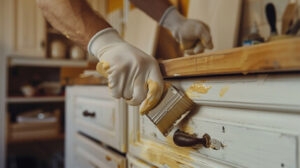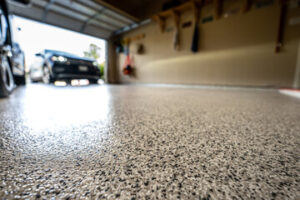Cabinet Refinishing Modesto Anchor is the quickest and most cost-effective way to update your kitchen cabinets. It works best when you want to change the color but don’t mind the style of your doors.

To refinish, your existing doors and drawer fronts are stripped using chemicals or a lot of sanding before new stain or paint is applied. It’s not the most durable option.
Cabinets are the backbone of any kitchen, and over time they can show signs of wear and tear. However, instead of replacing them, homeowners can give their cabinets a makeover to bring them back to life without breaking the bank. The two most popular options are to reface or replace them entirely. While refacing is a more comprehensive renovation process that replaces all the doors and drawer fronts, it’s also more expensive than refinishing.
Refinishing is a budget-friendly option that focuses on surface-only changes. It requires stripping the existing paint or stain, sanding, and then applying a fresh coat of color to the wood. This can be done on laminate, wood veneer, or solid-wood cabinets and is a great choice for those attempting to stay within a specific design budget. Refinishing is also long-lasting compared to a quick paint job, and it can hide minor scratches and other imperfections that might otherwise require replacement.
On the other hand, refacing is a more extensive project that completely replaces the cabinet doors and drawer fronts but keeps the existing cabinet boxes. The cost of refacing can be anywhere from $4,000 to $9,500, and is often more expensive than refinishing. Homeowners should also take into account the type of wood used in their cabinets when calculating costs, as different types of materials have different price points.
Regardless of which renovation process you choose, it’s important to find a professional who is experienced and licensed in your state. Many professionals offer a free consultation to discuss the project, cost, and timeline so you can be sure your new cabinets will be exactly what you want.
Whether you’re looking to revamp your current kitchen or add value to your home before selling it, a well-maintained kitchen can greatly increase its resale appeal. Choosing to refinish your cabinets rather than replace them can help you stay within your budget while achieving the aesthetic you’re after. Plus, you can use the money you save to invest in other home improvement projects or upgrades. With so many benefits, it’s clear why so many homeowners choose to refinish their cabinets rather than replace them.
Time-Saving
Cabinet refinishing is a green alternative to replacement because it keeps old materials from clogging landfills. Moreover, reusing existing cabinetry reduces waste by up to two-thirds, compared to a full replacement. However, it is important to understand that refinishing is not suitable for all types of cabinetry. For example, refinishing is not a good choice for thermofoil or laminate cabinets, since the surface can’t be sanded and stained. This type of renovation can also be difficult for homeowners who don’t have the time or expertise to do it themselves, so hiring a professional may be the best option.
While refinishing can be done in just days or weeks, it is important to allow for adequate time for the entire process. It is also recommended to protect countertops and floors during the refinishing process to avoid scratches, spills, or damage. Proper preparation is critical, especially when working with high-gloss finishes. A thorough cleaning and sanding of the cabinet boxes, drawer fronts, and doors is necessary to ensure a smooth, even finish.
During the refinishing process, it is also essential to choose the right stain color for your kitchen or bathroom. NHance offers several customizable options to make your cabinets stand out and complement your home’s overall aesthetic. You can go for a classic white, a trendy dark stain, or even a bold pop of color. Regardless of your desired aesthetic, refinishing is a great way to transform the look of your kitchen or bathroom without spending too much money.
Although cabinet refinishing is an effective, quick and affordable option to update your home’s interior design, it is not as durable as replacing or refacing. The longevity of your cabinet refinishing depends on the quality of your work and the materials used, as well as how often the cabinets are used. For example, frequent wiping and scrubbing can cause the finish to wear off more quickly than expected.
In addition, refinishing can be hazardous to your health because of the chemicals and fumes involved in the process. These fumes can irritate your eyes, nose, and throat and may even lead to respiratory problems. It is important to use a professional service that uses low-VOC (volatile organic compound) products, such as water-based paints and stain, to minimize exposure to these harmful substances.
Versatility
Cabinet refinishing offers homeowners the ability to achieve many styles without the expense and hassle of a full-scale replacement. Unlike refacing, which requires new doors and drawer fronts to be installed, this method simply refreshes the appearance of existing cabinets through sanding or painting. This versatility makes it a cost-effective, eco-conscious choice for many homeowners.
In addition to its aesthetic benefits, refinishing can also protect your cabinets from the wear and tear of daily kitchen use. A coat of durable finish or sealant helps shield them from moisture and grease, extending their lifespan and saving you money in the long run.
The process of cabinet refinishing, which is also known as repainting, allows you to choose from a wide range of paint colors and finishes that can match or complement your kitchen’s overall design scheme. You can opt for a classic wood stain, a sleek modern finish, or even a bold pop of color to add personality and flair. This allows you to customize your kitchen and give it a whole new look.
However, refinishing can be challenging if you’re not familiar with the process. It requires thorough sanding and preparation to ensure an even application and professional-looking results. If you’re not comfortable taking on this project yourself, working with a qualified contractor is the best option. A reputable company will have the expertise and equipment necessary to provide a flawless finish that will transform your kitchen.
One thing that you can’t do through refinishing is change the style profile of your door. This means that if you have arched raised panel doors, for example, you won’t be able to get them to look modern by changing the color. The good news is that you can restyle your cabinets through other methods, such as removing hardware or adding decorative knobs.
Finally, refinishing isn’t as durable as staining. It’s possible for a coat of finish to scratch or chip, especially if it’s applied unevenly or with poor quality materials. On the other hand, a well-done stain can last for years and be resistant to water damage and scratches.
Customization
Cabinet refinishing provides the opportunity to customize the look of your kitchen or bathroom. You can choose to keep your existing colors for a classic and timeless look or opt for bold hues to make a statement in the room. You can also alter the look of your cabinets by replacing solid doors with glass panes, or by adding custom shelving and storage solutions. Unlike cabinet replacement, which necessitates changing the layout of your space, cabinet refinishing allows you to retain the cabinet configuration and shelving that works best for your home.
Choosing whether to stain or paint your cabinets is another aspect of the process that offers flexibility and customization options. If your cabinets are in good condition with minimal imperfections, staining is a great option that will allow the natural beauty of the wood to shine through. On the other hand, if your cabinets have more extensive damage or you want to change their color completely, painting is a better choice.
If you’re planning to refinish your cabinets, it’s important to clean and prepare the surfaces before applying any new finish. This will ensure that the new finish adheres properly and results in a professional-looking appearance. For example, removing old hardware and sanding the surface will help prepare it for the new coating. In addition, it’s important to follow manufacturer recommendations for drying times to avoid damaging your new finish.
Cabinet refinishing is also a more environmentally friendly option than replacement because it reduces the amount of waste material that ends up in landfills. Additionally, refinishing is less toxic than traditional varnishes and paints.
Refinishing your cabinets is a time-consuming and labor-intensive project, but it can offer many benefits. It’s a cost-effective way to update your kitchen or bathroom and improve its aesthetics. It can also increase your home’s resale value and provide numerous customization options. By choosing a company that conducts their work at a facility outside of your home, you can minimize the environmental concerns associated with using harsh chemical treatments in your living space. This is particularly beneficial if you have young children or pets.


